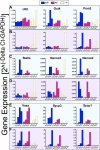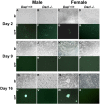Dazl functions in maintenance of pluripotency and genetic and epigenetic programs of differentiation in mouse primordial germ cells in vivo and in vitro
- PMID: 19468308
- PMCID: PMC2681483
- DOI: 10.1371/journal.pone.0005654
Dazl functions in maintenance of pluripotency and genetic and epigenetic programs of differentiation in mouse primordial germ cells in vivo and in vitro
Abstract
Background: Mammalian germ cells progress through a unique developmental program that encompasses proliferation and migration of the nascent primordial germ cell (PGC) population, reprogramming of nuclear DNA to reset imprinted gene expression, and differentiation of mature gametes. Little is known of the genes that regulate quantitative and qualitative aspects of early mammalian germ cell development both in vivo, and during differentiation of germ cells from mouse embryonic stem cells (mESCs) in vitro.
Methodology and principal findings: We used a transgenic mouse system that enabled isolation of small numbers of Oct4DeltaPE:GFP-positive germ cells in vivo, and following differentiation from mESCs in vitro, to uncover quantitate and qualitative phenotypes associated with the disruption of a single translational regulator, Dazl. We demonstrate that disruption of Dazl results in a post-migratory, pre-meiotic reduction in PGC number accompanied by aberrant expression of pluripotency genes and failure to erase and re-establish genomic imprints in isolated male and female PGCs, as well as subsequent defect in progression through meiosis. Moreover, the phenotypes observed in vivo were mirrored by those in vitro, with inability of isolated mutant PGCs to establish pluripotent EG (embryonic germ) cell lines and few residual Oct-4-expressing cells remaining after somatic differentiation of mESCs carrying a Dazl null mutation. Finally, we observed that even within undifferentiated mESCs, a nascent germ cell subpopulation exists that was effectively eliminated with ablation of Dazl.
Conclusions and significance: This report establishes the translational regulator Dazl as a component of pluripotency, genetic, and epigenetic programs at multiple time points of germ cell development in vivo and in vitro, and validates use of the ESC system to model and explore germ cell biology.
Conflict of interest statement
Figures









Similar articles
-
DAZL limits pluripotency, differentiation, and apoptosis in developing primordial germ cells.Stem Cell Reports. 2014 Nov 11;3(5):892-904. doi: 10.1016/j.stemcr.2014.09.003. Epub 2014 Oct 11. Stem Cell Reports. 2014. PMID: 25418731 Free PMC article.
-
Erasure of DNA methylation, genomic imprints, and epimutations in a primordial germ-cell model derived from mouse pluripotent stem cells.Proc Natl Acad Sci U S A. 2016 Aug 23;113(34):9545-50. doi: 10.1073/pnas.1610259113. Epub 2016 Aug 2. Proc Natl Acad Sci U S A. 2016. PMID: 27486249 Free PMC article.
-
Derivation of embryonic germ cells from post migratory primordial germ cells, and methylation analysis of their imprinted genes by bisulfite genomic sequencing.Mol Cells. 2008 May 31;25(3):358-67. Epub 2008 Apr 1. Mol Cells. 2008. PMID: 18443423
-
The reciprocal relationship between primordial germ cells and pluripotent stem cells.J Mol Med (Berl). 2012 Jul;90(7):753-61. doi: 10.1007/s00109-012-0912-1. Epub 2012 May 15. J Mol Med (Berl). 2012. PMID: 22584374 Review.
-
Foetal germ cells: striking the balance between pluripotency and differentiation.Int J Dev Biol. 2009;53(2-3):393-409. doi: 10.1387/ijdb.082671pw. Int J Dev Biol. 2009. PMID: 19412894 Review.
Cited by
-
Single cell epigenomic and transcriptomic analysis uncovers potential transcription factors regulating mitotic/meiotic switch.Cell Death Dis. 2023 Feb 17;14(2):134. doi: 10.1038/s41419-023-05671-w. Cell Death Dis. 2023. PMID: 36797258 Free PMC article.
-
Transplantation directs oocyte maturation from embryonic stem cells and provides a therapeutic strategy for female infertility.Hum Mol Genet. 2009 Nov 15;18(22):4376-89. doi: 10.1093/hmg/ddp393. Epub 2009 Aug 20. Hum Mol Genet. 2009. PMID: 19696121 Free PMC article.
-
Transcriptional regulation of P63 on the apoptosis of male germ cells and three stages of spermatogenesis in mice.Cell Death Dis. 2018 Jan 23;9(2):76. doi: 10.1038/s41419-017-0046-z. Cell Death Dis. 2018. PMID: 29362488 Free PMC article.
-
Learning biomarkers of pluripotent stem cells in mouse.DNA Res. 2011 Aug;18(4):233-51. doi: 10.1093/dnares/dsr016. Epub 2011 Jul 26. DNA Res. 2011. PMID: 21791477 Free PMC article.
-
Germ-granule components prevent somatic development in the C. elegans germline.Curr Biol. 2014 May 5;24(9):970-5. doi: 10.1016/j.cub.2014.03.015. Epub 2014 Apr 17. Curr Biol. 2014. PMID: 24746798 Free PMC article.
References
-
- Okamura D, Hayashi K, Matsui Y. Mouse epiblasts change responsiveness to BMP4 signal required for PGC formation through functions of extraembryonic ectoderm. Mol Reprod Dev. 2005;70:20–29. - PubMed
-
- Ohinata Y, Payer B, O'Carroll D, Ancelin K, Ono Y, et al. Blimp1 is a critical determinant of the germ cell lineage in mice. Nature. 2005;436:207–213. - PubMed
-
- Vincent SD, Dunn NR, Sciammas R, Shapiro-Shalef M, Davis MM, et al. The zinc finger transcriptional repressor Blimp1/Prdm1 is dispensable for early axis formation but is required for specification of primordial germ cells in the mouse. Development. 2005;132:1315–1325. - PubMed
-
- Saitou M, Barton SC, Surani MA. A molecular programme for the specification of germ cell fate in mice. Nature. 2002;418:293–300. - PubMed
Publication types
MeSH terms
Substances
Grants and funding
LinkOut - more resources
Full Text Sources
Molecular Biology Databases

